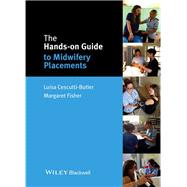The perfect companion for student midwives in clinical settings, packed full of useful and practical information to help guide and enable you to get the best out of your midwifery placements. This compact, portable text includes what to expect on each type of placement – whether it be working in a low or high risk environment – from how to prepare for practice, what you can anticipate whilst you’re there, the key essential skills to acquire, what pitfalls and problems to be aware of, and how to deal with them if they do arise. Each chapter contains ‘Top Tips’ from current or recently qualified midwifery students, as well as real life student experiences and suggestions for further readings.








